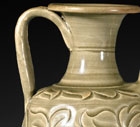J.J. Lally & Co., Oriental Art / New York City, New York
MenuPast Exhibition
SONG DYNASTY CERAMICS:
The Ronald W. Longsdorf Collection
March 15 - April 13, 2013
5.
A CARVED YAOZHOU CELADON EWER
Northern Song Dynasty (A.D. 960-1127)
boldly carved with two large peony blossoms surrounded by clusters of leaves on curling stems filling the rounded sides of the upright ovoid body below deeply carved overlapping petal motifs on the narrow shoulder, the waisted neck with incised double-line collar at the center, the ribbed strap handle rising from the shoulder to a high arch beside the rolled rim of the trumpet mouth, the curving spout rising opposite the handle, all covered with a lustrous glaze of deep olive-green tone continuing over the base, the wide ring foot unglazed revealing the gray stoneware.
Height 8 1⁄4 inches (21 cm)
A carved Yaozhou celadon ewer of very similar form and design excavated at Baoji county, Shaanxi province from the tomb of Ma Deyuan, dated by epitaph to the seventh year of Zhenghe, corresponding to A.D. 1117, is illustrated by Liu, Dated Ceramics of the Song, Liao, and Jin Periods, Beijing, 2004, p. 25, fig. 2-16.
Compare also the carved Yaozhou ewer of similar form, with short applied sprigs at the base of the neck, excavated in 1989 at Yao county, Shaanxi province, and now in the Yaozhou Ware Museum, illustrated in the catalogue of the exhibition at The Museum of Oriental Ceramics, Osaka entitled The Masterpieces of Yaozhou Ware, Osaka, 1997, p. 56, no. 73. Another similar example is illustrated by Krahl in Chinese Ceramics from the Meiyintang Collection, Volume One, London, 1994, pp. 234-235, no. 423. Two other similar Yaozhou celadon ewers, one from the Alexander Collection, now in the Baur Museum, Geneva, and the other from the Brundage Collection, now in the Asian Art Museum of San Francisco, are illustrated by Wirgin, ‘Sung Ceramic Designs,’ B.M.F.E.A. Bulletin No. 42, Stockholm, 1970, pls. 3a and 3b.
北宋 耀州青瓷刻花牡丹紋執壺 高 21 厘米
